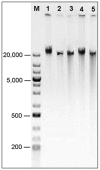Evaluation of five methods for total DNA extraction from western corn rootworm beetles
- PMID: 20730102
- PMCID: PMC2921343
- DOI: 10.1371/journal.pone.0011963
Evaluation of five methods for total DNA extraction from western corn rootworm beetles
Abstract
Background: DNA extraction is a routine step in many insect molecular studies. A variety of methods have been used to isolate DNA molecules from insects, and many commercial kits are available. Extraction methods need to be evaluated for their efficiency, cost, and side effects such as DNA degradation during extraction.
Methodology/principal findings: From individual western corn rootworm beetles, Diabrotica virgifera virgifera, DNA extractions by the SDS method, CTAB method, DNAzol reagent, Puregene solutions and DNeasy column were compared in terms of DNA quantity and quality, cost of materials, and time consumed. Although all five methods resulted in acceptable DNA concentrations and absorbance ratios, the SDS and CTAB methods resulted in higher DNA yield (ng DNA vs. mg tissue) at much lower cost and less degradation as revealed on agarose gels. The DNeasy kit was most time-efficient but was the costliest among the methods tested. The effects of ethanol volume, temperature and incubation time on precipitation of DNA were also investigated. The DNA samples obtained by the five methods were tested in PCR for six microsatellites located in various positions of the beetle's genome, and all samples showed successful amplifications.
Conclusion/significance: These evaluations provide a guide for choosing methods of DNA extraction from western corn rootworm beetles based on expected DNA yield and quality, extraction time, cost, and waste control. The extraction conditions for this mid-size insect were optimized. The DNA extracted by the five methods was suitable for further molecular applications such as PCR and sequencing by synthesis.
Conflict of interest statement
Figures


References
-
- Milligan BG. Total DNA isolation. In: Hoelzel AR, editor. Oxford, , New York, Tokyo: Oxford University Press; 1998. pp. 29–64. Molecular Genetic Analysis of Population: A Practical Approach, 2nd Edition.
-
- Waldschmidt AM. Extraction of genomic DNA from Melipona quadrifasciata (Hymenoptera: Apidae, Meliponinae). Braz J Genet. 1997;20:421–423.
-
- Chen M, Zhu Y, Tao J, Luo Y. Methodological comparison of DNA extraction from Holcocerrus hippophaecolus (Lepidoptera: Cossidae) for AFLP analysis. For Study China. 2008;10:189–192.
-
- Chomczynski P, Mackey K, Drews R, Wilfinger W. DNAzol: A reagent for the rapid isolation of genomic DNA. BioTechniques. 1997;22:550–553. - PubMed
-
- Chomczynski P, Wilfinger W, Mackey K. Isolation of Genomic DNA from Human, Animal, and Plant Samples with DNAzol Reagents. Biotechnol Int. 1998:185–188.
Publication types
MeSH terms
Substances
LinkOut - more resources
Full Text Sources

